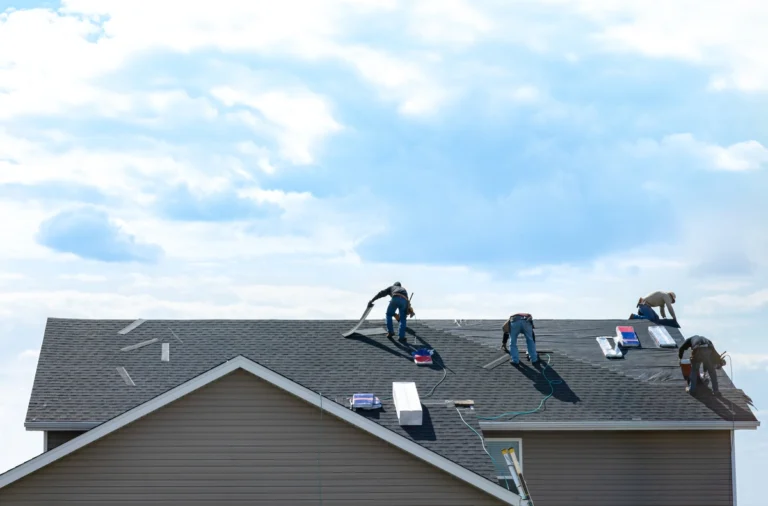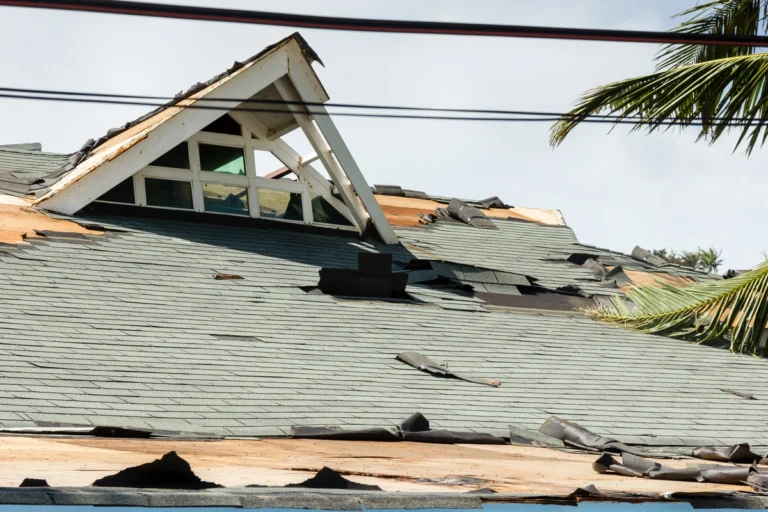Most people will hear the wind pick up outside and think nothing of it until the lights are flickering like there is an old, faulty switch. Yet residential and commercial building owners alike should be aware that any time strong, persistent winds are blustering outside, their roofing systems are often taking the brunt of the weather blitz.
When strong winds blow, it’s time to get a roof inspection.
Flat Roof Systems
Many commercial properties have flat roofs to accommodate sizable roof-mounted HVAC systems. While these roofs are called flat, they still have a slight pitch to funnel water or melting snow off the roof to prevent it from pooling on the surface and causing issues, such as leaks and rot. When you add the element of wind, however, the roofing system can sustain sufficient damage to allow moisture to seep underneath the roofing material.
A flat commercial roofing system can generally be made of one of five different roofing materials:
1. Also called rubber roofing, ethylene propylene diene monomer (EPDM) is an extremely durable synthetic membrane that is commonly used on commercial roofs. It has an expected lifespan of 40 to 50 years and is also cost-effective.
2. Modified bitumen is an asphalt-based membrane designed for buildings with flat or low-slope roof structures. It typically consists of several layers of protection and has a service life of 12 to 20 years.
3. Built-up roofing, also called BUR, is composed of alternating layers of reinforcing bitumen and fabric. It is finished with a layer of aggregates, such as stone or gravel.
4. Another membrane meant for low-slope or flat roofs is called single-ply. It has fewer seams than asphalt rolled systems and comes with prefabricated accessories that make the professional installation a lot easier.
5. Metal roofing is extremely lightweight and energy-efficient. Aluminum, zinc, stainless steel and copper are common metal roofing materials installed on commercial buildings.
How Does Wind Damage Your Roof?
The severity of wind damage to a flat roofing structure depends on several factors. These include:
- Age and type of roofing materials used
- Presence of flying debris
- The shape and building geometry of the roof
- The orientation and building height of the roof
- The quality of roof installation
Wind Uplift
A serious problem that affects flat roofs is wind uplift. It is defined as the suction generated by wind forces as the air glides parallel to the surface of the roof. As a puff of wind meets the side of the roofing structure, the portion of the air is directed upward and then across the roof. In simpler terms, it is where the strong air gets underneath the roofing material and hauls it up. This common issue can leave the roof with wrinkles or bubbles below the surface due to the membrane or material not being firmly and securely attached.
Keep in mind that when your loose or detached roofing membrane is pulled up from the surface, rain or moisture can trickle into the system and start to rot out the underlying materials until the entire roof is deemed ineffective. To stave off wind uplifting, the metal edge flashing should be installed and fastened securely by the roofer. If the fascia boards are loose or if a strong wind pulls them off, it can also tear off the metal flashing, so it is important to fasten them down as well. Be sure to conduct regular inspections to ensure that the edge flashing and fascia boards are in good condition. Have them replaced immediately if you see signs of damage.
Wind Scouring
In addition to wind uplifting, another wind-related problem that flat roofs commonly deal with is wind scouring, which is generally defined as the process where powerful winds carry snow away from windward slopes. It occurs when the blast of wind is strong enough to pull off the protective granules from the roofing membrane or remove the gravel applied as a surface coating on BURs. While there may be no prompt or clear-cut indication of wind-related damage, wind scouring can have a perilous effect on the life of commercial flat roofs. The roofing system can appear a bit worn-out and deteriorate a lot faster than expected. Partial or total roof failure can immediately result in the need for the installation of a brand new roof.
What Types of Winds Cause Roof Damage?
There are different categories of powerful winds that can inflict damage on your flat roofing system. In fact, while hurricanes and tornadoes are responsible for a significant percentage of damage, over half of the severe wind-related damage is caused by strong winds stirred up during intense thunderstorms. Damaging winds can come in a form of macrobursts, microbursts and straight-line winds that can anchor hurricane-force winds over expansive strips of land.
- Hurricane winds are classified as winds above 74 miles per hour (mph). When the speed of winds at a low range increases, devastation often follows – creating flying debris out of tree branches, paper, packaging and more. The strongest hurricane winds typically top out around 200 mph. Due to the long period of these storms, they can freely pound away at commercial buildings and facilities. Some roofing systems are resistant to low-level winds carried by hurricanes while others become severely damaged. Minor damage to older roof shingles, vinyl siding and gutters is categorized as minimal hurricane damage. On the other hand, total roof failure, wall collapse and building collapse are warning signs of severe hurricane damage.
- Tornado winds are also incredibly destructive forces of nature. A tornado is a rapid, hard-hitting storm that covers a few hundred miles and more. It can bring about intense winds with speeds reaching 300 mph during the most extreme storms. While the long duration of high hurricane winds can cause widespread damage, tornadoes can completely eliminate strapping structures in mere seconds.
- Straight-line winds come out of thunderstorms and include wind gusts of 100 mph or more. There is no doubt that these winds can do severe damage to roofing systems and building structures.
- A derecho is a long-lasting and widespread straight-line wind storm that hovers over expansive areas. It is often associated with fast-moving thunderstorms and consists of numerous macrobursts, microbursts and downburst clusters. A derecho is also defined by wind-related damage that extends more than 240 miles and includes wind gusts of at least 58 mph.
Let Bay Valley Contractors Help Achieve Your Dream Exterior
Breathe new life into your home with a high-quality roof makeover. Bay Valley Contractors is a premier source of flat roofing and solar roofing solutions in Concord, CA, and the surrounding communities. We also install gutters, build additions and remodel living spaces. Our certified and experienced professionals are committed to providing the comfort and efficiency you need through industry-leading products and outstanding customer service. Call us today at (925) 718-0780, or fill out our contact form to set up an appointment or request a free, no-obligation estimate.





